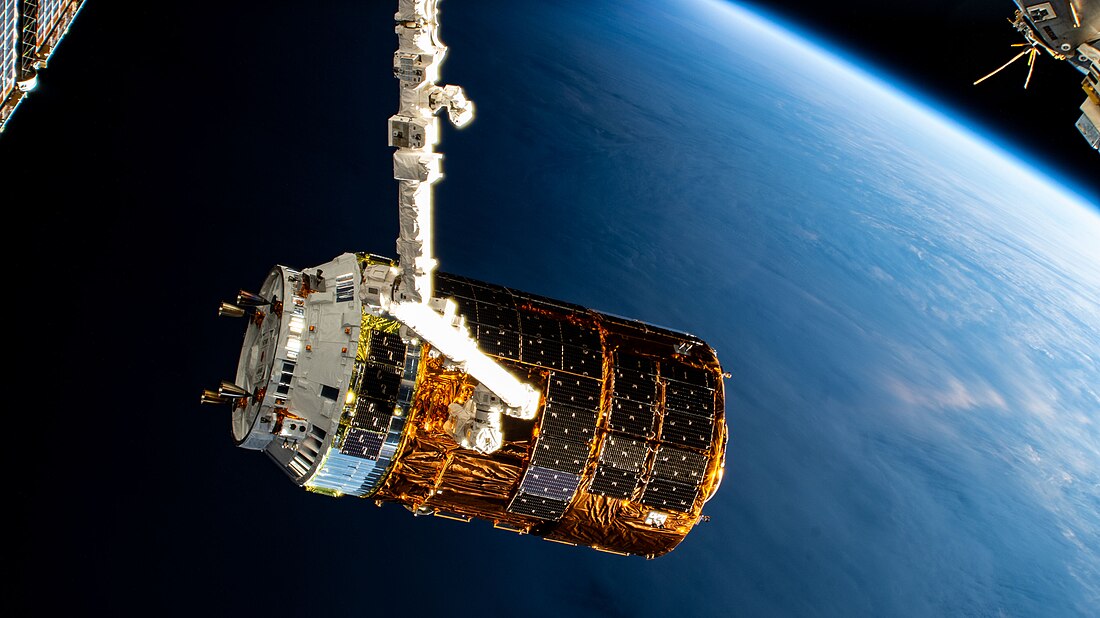Top Qs
Timeline
Chat
Perspective
Kounotori 8
2019 Japanese resupply spaceflight to the ISS From Wikipedia, the free encyclopedia
Remove ads
Kounotori 8 (こうのとり8号機), also known as HTV-8 was the 8th flight of the H-II Transfer Vehicle, a robotic cargo spacecraft to resupply the International Space Station. It was launched on 24 September 2019, 16:05:05 UTC.[8]
Remove ads
Spacecraft
Major changes from previous Kounotori are:[9]
- Replacement of Earth sensor with star tracker for spacecraft attitude control
- New cargo racks developed for HTV-X which allows 30% more Cargo Transfer Bags (CTB) to be carried in the Pressurized Logistics Carrier (PLC). (316 CTBs for Kounotori 8, compared to 248 CTBs of Kounotori 6)
Cargo
Summarize
Perspective
Kounotori 8 carries about 5300 kg of cargo, consisting of 3400 kg in the pressurized compartment and 1900 kg in the unpressurized compartment.[9]
Cargo in the Pressurized Logistics Carrier (PLC) include:[9]
- JAXA experiment Cell Biology Experiment Facility-Left (CBEF-L)
- JAXA experiment Sony Optical Link for ISS (SOLISS), a satellite optical communication demonstration co-developed with Sony Computer Science Laboratories
- JAXA experiment Hourglass, which will investigate the behavior of soil and rock particles under low gravity conditions[10]
- Gas bottle for JAXA experiment
- Experiment materials for Electrostatic Levitation Furnace (ELF)
- CubeSats to be deployed from ISS: NARSSCube-1, AQT-D, RWASAT-1
- NASA system supply cargo: new water tank for Water Storage System (WSS)
- NASA system supply cargo: tank for Nitrogen Oxygen Recharge System (NORS)
In the Unpressurized Logistics Carrier (ULC), Kounotori 8 carries six lithium-ion batteries Orbital Replacement Units (ORUs) for replacing the ISS's existing nickel-hydrogen batteries. The transportation of replacement batteries is a continuation from the previous Kounotori 6 and 7, and will continue through to Kounotori 9.[9]
Remove ads
Operation
Summarize
Perspective
Launch
The H-IIB launch vehicle carrying Kounotori 8 was initially scheduled to be launched at 21:33:29 UTC, 10 September 2019.[11][12] During launch preparation, a fire broke out at the launch pad at around 18:05 UTC (T minus 3.5 hours), and the launch was called off.[13] The cause of fire was attributed to the static electricity on the heat resistant material under the mixture of liquid oxygen and gas oxygen for the engine pre-cooling.[14]
After the modification to the mobile launch platform to suppress static electricity, a new launch was scheduled at 23 September 2019, 16:30 UTC,[14] but the collision avoidance check revealed that the 2nd stage of the launch vehicle might approach near the Soyuz MS-15 which was scheduled to be launched on 25 September 2019. A revised launch schedule was set for 16:05 UTC, 24 September 2019.[15] On 24 September 2019, 16:05:05 UTC, the Kounotori 8 aboard H-IIB was launched successfully.[8]
Operation while berthed to the ISS
Kounotori 8 was captured by the Space Station Remote Manipulator System (SSRMS) at 23:13 UTC, on 27 September 2019,[16] and berthed at Harmony's nadir Common Berthing Mechanism (CBM) by 17:55 UTC, on 28 September 2019.[17]
The External Palette (EP8), which carries the lithium-ion battery Orbital Replacement Units (ORU), was extracted from the Kounotori 8's Unpressurized Logistics Carrier (ULC) by the SSRMS (Canadarm2) on 29 September 2019.[18]
The External Palette of Kounotori 7 (EP7) was placed in the Kounotori 8's ULC.[19] EP7 was left on the ISS after the departure of Kounotori 7 due to the schedule change of extravehicular activity after the launch failure of Soyuz MS-10.
Departure and reentry to the Earth atmosphere
On 1 November 2019, Kounotori 8 was detached from Harmony's CBM by the SSRMS (Canadarm2), and it was released into orbit at 17:20 UTC.[20]
It was disposed by the destructive reentry to the Earth atmosphere at around 02:09 UTC, on 3 November 2019.[21]
References
External links
Wikiwand - on
Seamless Wikipedia browsing. On steroids.
Remove ads

